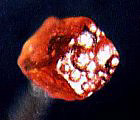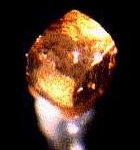 |
|||
|
|||
|
Copyright
Cubic Garnets Found in Maryland and Virginia Streams
BackgroundCommencing in early 1992, I began finding cube-shaped, mostly orange-red colored garnets in the heavy mineral concentrates of Rock Run, a small Montgomery County, Maryland stream about 9 kilometers long, which flows southeasterly from just north of Potomac Village to the Potomac River. Their typical shapes were like sharp cubes except that the faces were slightly convex and seemed to have many circular growth hillocks. I had been panning only since mid-1991, and had discovered that I could find many interesting and beautiful micromineral specimens for my micromounting interests by examining the black sands under my microscope. At first, I would find these very tiny (from 1 mm to less than 0.1 mm) cubic forms very infrequently, but I saved them, believing that someday I. would get them identified. Later in 1992, several members of my micro club, Micromineralogists of the National Capital Area, said they believed them to be garnet cleavage fragments, though they were not sure. I still suspected that they were natural garnet crystals, and to me, they did not appear to be fragments because the shape seemed to be too consistently perfect. They did not seem to have the vitreous surface I had become familiar with among the many garnet fragments encountered in the black sands of not only Rock Run, but most of the other County streamsFor nearly the next two years, I continued with my micromounting interests and gold panning, and continued to find occasional "cubics" in Rock Run. (Rock Run is my favorite stream for gold panning, because there I found enough gold to make the three rings for my 1994 engagement and wedding!)
GeologyThe major country rock in the area of the Rock Run watershed (and those of the other two Maryland streams and one Arlington, Virginia stream in which I later found cubic garnets) is interlayered mica schist and metamorphosed graywacke. It is a thick sequence of metasedimentary rock, probably of lower paleozoic or Precambrian origin, that is exposed in extensive areas of the Piedmont, including stretches of Virginia, Maryland and Pennsylvania. (Many granitic pegmatites also exist in these areas of the Piedmont). These schists, though composed primarily of quartz, plagioclase, muscovite, biotite, and chlorite, contain other relict grains of sillimanite, kyanite, garnet, and potassic feldspar. One other Western Fluvanna County, Virginia stream in which I found a cubic, is in a bedrock described as interbanded metavolcanics and metasedimentary rocks of lower Cambrian or upper precambrian age.Minerals I have noted in stream concentrates include: actinolite, anatase, columbite/tantalite, epidote, feldspars (albite, amazonite, perthite), garnet (almandine, spessartine and several other species), gold, hafnon/zircon, hematite, limonite pseudomorphs after pyrite, magnetite, mica (biotite, muscovite, zinnwaldite, sericite), monazite, pyrite, quartz, rutile, schorl, staurolite, zircon and some others. (The underlined minerals came from only one stream location, Lamberton Branch, which crosses a complex pegmatite just south of the old Kensington Mica Mine in Montgomery County).
IdentificationBy the time of the 23rd Atlantic Micromounter's Conference, held at the University of Maryland in late March 1995, I had also been finding some light pink cubic almandines in some graded and screened sandblasting garnet from a commercial garnet operation at Carpenter Creek near Fernwood, Idaho. I had found more cubics in the Idaho material than I had found in the Rock Run concentrates, and I remained just as puzzled by the cubes as when I found the first one in early 1992. A recent measurement I had made of the Idaho sample revealed that approximately 1.17% (by weight) of the material was cubic crystals.
Foord completed his work on them later that year and by the time of the 23rd Rochester Mineralogical Symposium (RMS) in April 1996, he included his findings in a paper he presented there, entitled "Cubic and Octahedral Garnets: Maryland, USA, Brazil, and Italy". In it, he wrote: "Cubic reddish spessartine (RI, XRD, EDS, this study) crystals (1 mm) have been found as isolated crystals along with other detrital minerals (dodecahedral almandine, magnetite, limonite pseudomorphs after pyrite, epidote, rutile, gold, etc.) in sand from Rock Run, Montgomery County, Maryland. The Maryland cubic garnets are similar in appearance to the Brazilian cubic almandines."He described the Brazilian almandines as follows: "The Brazilian cubic almandines are transparent, equidimensional crystals (1-2 mm) without matrix. The crystals have rounded, slightly convex faces that have razor sharp intersections. The convex faces are patterned with myriad tightly overlapping circular to elliptical growth mounds, some of which are smooth, but most of which are pitted or have growth hillocks ..."Later, in the popular annual RMS feature, "What's New in Minerals?" Vandall King, Steve Chamberlain, and Jeffrey Scovil, wrote: "Jack Nelson has been panning gold from Rock Run, Montgomery County, Maryland. Being a micromounter, he examined some of the minerals in his heavy mineral concentrates ... and found some cubic orange to orange brown garnet crystals! The cubes (to 1 mm) are pure forms with no modifications, but do show rounding and orange-peel surface texture as is common with cubic garnets from other localities. Gene Foord chemically analyzed, X-rayed, and measured the refractive indices and showed that the cubes are ferroan spessartine. The cubic garnets are probably the first found in the U.S.A." Further findsDuring the year following the RMS of April 1996, Foord was advising me concerning my collecting methods. He believed that I should try to find a source of the cubes, i.e., find some in situ, basically meaning to find some of them in place in the schist (or pegmatite) where they crystallized. I tried to do that by recovering fragments of schist in each of the locations where I was panning, crushing them, and then panning out the crushed schist. I did this with material from a number of locations where I had found cubics originally, but I found none. He also suggested other sampling techniques, and offered to test and analyze other specimens.I continued to examine the heavy mineral concentrates from other new locations in Maryland and Virginia, and even one location in southeastern Pennsylvania. In September 1996, I found 20 cubic garnets in Long Branch, a stream in Arlington, Virginia, adjacent to the Nature Center where our club conducts its meetings. Long Branch flows through similar geologic structures as Rock Run does. A month later, the heavy mineral concentrates from a tiny unnamed tributary to Byrd Creek,, about 2 miles from the town of Caledonia, Fluvanna County, Virginia yielded yet another cubic garnet. All the Maryland and Virginia cubes are similar in color and appearance. I then began to examine the concentrates I had, saved from the other fifty or so stream locations I had visited since I began panning in 1991. In two of the samples I have found cubic garnets and both of those streams flow through similar geologic formations as Rock Run. One of those two streams, Lamberton Branch, also crosses a complex pegmatite about a quarter mile southwest of the old Kensington Mica Mine, in the Kemp Mill section of Silver Spring, Maryland. Foord speculated that these pegmatites could also be a source for cubic spessartines. Are cubic garnets rare?I don't think so. Lanny Ream recently made a closer examination of some garnet concentrates from the Fernwood, Idaho area that he had collected many years ago, and found a considerable number of cubic garnets. He said that he now considers them not rare - merely not looked for, and I would agree. If you consider that 1.17 % (by weight) of the Idaho sample I examined was cubic garnet, then you could also assume that these cubic forms are not rare. I suspect that there are extremely few people, amateurs, or for that matter, professional geologists or mineralogists, who search heavy mineral concentrates looking for such crystal forms, especially when you consider their small size: less than 1.0 mm, with most of them being less than 0.25 mm.It will be interesting to see how many more "finds" of cubic garnets can be made as more people search the streams in their local areas. The author encourages all who may find any to contact him with information. Intermediate Crystal FormsFoord, in his paper cited above, stated that garnet forms are usually predominantly trapezohedral and dodecahedral forms, but that combinations of the two less frequently occur. He adds that cube faces are considered rare on garnet and usually occur on grossular. Dominant cube faces from several localities have been reported. Brazilian cubic almandines and these ferroan spessartines from Rock Run are "pure forms", transparent and equidimensional crystals and have been found without matrix.Foord stated that the Brazilian cubic almandines show an "occasional isolated face at the intersection of the three cube faces", but that the isolated faces "are irregular and have not been identified." I have noticed that a considerable percentage (perhaps 30%) of the "cubics" that I have found in Rock Run and Long Branch seem to have unusual striated faces located just between adjoining cube faces (the striations are perpendicular to the intersection of the cube faces). So, as there are combinations and modifications of the predominant dodecahedral and trapezohedral garnet forms, there appears to be modifications among some of the pure cubes, as well. Cubic Garnets make ideal MicromountsSince these unusual crystal forms have been (thus far) so small, they can pose a significant challenge to "single crystal" micromounters. Paul Smith of Fairfax, Virginia has refined the use of animal whiskers, (cat, squirrel, etc.), and I have done the same with porcupine quills, for mounting specimens as small as less than 0.1 mm. We each have written "how to" articles about the techniques as part of a series on "Micromounting Techniques" in the Mineral Mite, the newsletter of the Micromineralogists of the National Capital Area. (For copies, contact the author who is Editor of the Mite). One day, if someone finds cubics in matrix or finds twinned examples of these crystal forms, we may be able to revert to more traditional mounting techniques.References
This article may not be copied, distributed or reprinted in any form without the author's permission. To contact the author, please use the e-mail address provided. If you are unable to contact the author, please contact the Canadian Rockhound. Authorized reprints must acknowledge the author and the Canadian Rockhound, and include the website URL address of the Canadian Rockhound.
|
||||

Copyright © 1999 Canadian Rockhound
Magazine Issues |
News & Events |
Junior Rockhound |
Resources
|
||||

